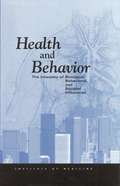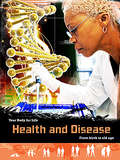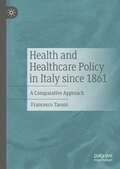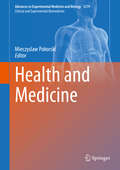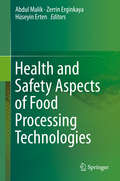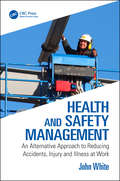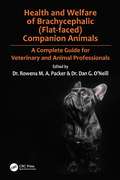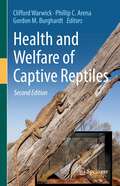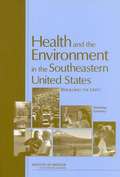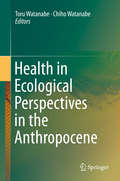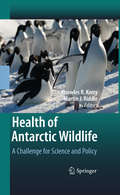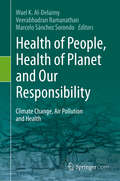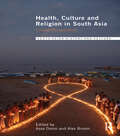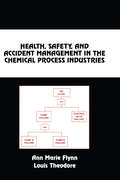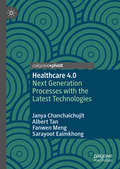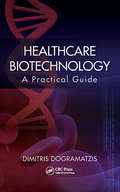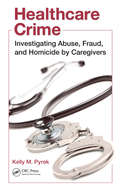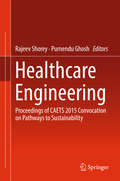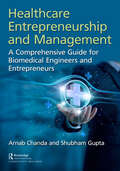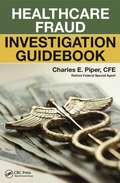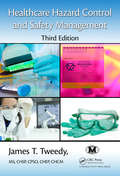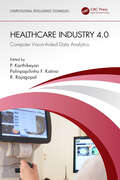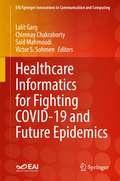- Table View
- List View
Health and Behavior: The Interplay of Biological, Behavioral, and Societal Influences
by National Research CouncilHealth and Behavior reviews our improved understanding of the complex interplay among biological, psychological, and social influences and explores findings suggested by recent research-including interventions at multiple levels that we can employ to improve human health. The book covers three main areas: What do biological, behavioral, and social sciences contribute to our understanding of health-including cardiovascular, immune system and brain functioning, behaviors that influence health, the role of social networks and socioeconomic status, and more. What can we learn from applied research on interventions to improve the health of individuals, families, communities, organizations, and larger populations? How can we expeditiously translate research findings into application?
Health and Disease: From Birth to Old Age (Your Body For Life)
by Louise SpilsburyEveryone is an individual and we’re all different in many ways, but every human being on Earth follows a similar pattern of changes from birth to childhood, through adolescence to adulthood, and into old age. This book shows how our health and our ability to deal with disease change over time, too - such as how our immune system develops, the role of our genes and nutrition, the impact of unhealthy behaviors, and the effects of aging.
Health and Healthcare Policy in Italy since 1861: A Comparative Approach
by Francesco TaroniProviding a historical overview of healthcare in Italy from its unification in 1861 to the present COVID-19 pandemic, this book analyses the political, social and cultural impact of Italian healthcare policy and medicine. The author examines the development of public health, hospitals, and primary care, and the building of healthcare systems across three political regimes in Italy: the liberal period (1861-1914), Fascism (1922-43), and the Italian Republic (1948 to the present day). By emphasising the embeddedness of health-related legislation in Italy’s political and social background, this book offers a comparative account of Italian health policy, and contrasts this with developments in neighbouring European countries, Canada and the United States. The book focuses on the Italian government’s reaction to the social and political impact of several diseases: pellagra; cholera; malaria; and tuberculosis, and explores the present-day response to the current COVID-19 pandemic. A timely and comprehensive read, this book will appeal to those teaching and researching Italian history and the history of medicine and healthcare more widely.
Health and Medicine (Advances in Experimental Medicine and Biology #1279)
by Mieczyslaw PokorskiThis book offers a reliable source of information on the latest advances and current trends in the medical and clinical sciences. The focus is on certain fields that are of consistently high practical interest due to widespread disease morbidity, and on pathomechanisms that are not yet fully understood and their treatment. The topics covered include, but are not limited to, the search for novel biomarkers of colorectal cancer, morbidity and mortality after traumatic brain injuries, and impairment in brain-controlled muscle mechanisms after stroke. In addition, problematic issues in pulmonary medicine are discussed at length. These issues, notably, concern human studies that have set the standards for allergy, sensory irritation, and sensitization research, as well as studies on the management and treatment of chronic obstructive pulmonary disease and obstructive sleep apnea. Lastly, the book addresses various aspects of commonplace viral respiratory infections, such as vulnerability and transmission in both pediatric and adult populations, flue vaccination coverage, and post-infectious respiratory complications. . The book’s goal is to promote the restoration and maintenance of good health, disease prophylaxis, and improved patient management by integrating research into clinical work and findings on improving care. It offers a valuable asset for clinical specialists, researchers, and everyone engaged in healthcare.
Health and Safety Aspects of Food Processing Technologies
by Abdul Malik Zerrin Erginkaya Hüseyin ErtenFood processing is expected to affect content, activity and bioavailability of nutrients; the health-promoting capacity of food products depends on their processing history. Traditional technologies, such as the use of antimicrobials and thermal processing, are efficient in increasing nutritional value to an extent, though they may not be effective at addressing food safety, particularly when it comes to maintaining the food's molecular structure. Modern food processing plants improve the quality of life for people with allergies, diabetics, and others who cannot consume some common food elements. Food processing can also add extra nutrients, such as vitamins. Processed foods are often less susceptible to early spoilage than fresh foods and are better suited for long-distance transportation from the source to the consumer. However, food processing can also decrease the nutritional value of foods and introduce hazards not encountered with naturally occurring products. Processed foods often include food additives, such as flavourings and texture-enhancing agents, which may have little or no nutritive value, and may in fact be unhealthy.This book deals with the subject of food processing in a unique way, providing an overview not only of current techniques in food processing and preservation (i.e., dairy, meat, cereal, vegetables, fruits and juice processing, etc.) but also the health and safety aspects: food technologies that improve nutritional quality of foods, functional foods, and nanotechnology in the food and agriculture industry. The text also looks into the future by defining current bottlenecks and future research goals. This work will serve as a ready reference for the subject matter to students and researchers alike.
Health and Safety Management: An Alternative Approach to Reducing Accidents, Injury and Illness at Work
by John WhiteAt a time when our knowledge and understanding of health and safety at work is at its highest, statistics show that ongoing improvements in accident rates and time taken off work due to injury and ill-health are stagnating. Alongside the fact that around 80% of accidents can be attributed to human error, there is also increasing concern that modern-world issues of mental and physical wellbeing are undermining recent gains made ensuring the safety of people at work. <P><P>By applying the principles of marginal gain and using lessons drawn from the high-risk world of outdoor adventure and high level sport, this book provides a variety of practical solutions and seeks to reduce the incidence of human error in the workplace and the number of accidents and near-misses. The concept of Free Thinking Hazard Identification is introduced alongside the importance of managing changing circumstances and minimising the frequently underestimated risk to experienced workers. A range of practical recommendations are also made to help reduce time taken off work due to injury or ill-health, through managing fitness, diet and health and paying attention to mental wellbeing.
Health and Welfare of Brachycephalic (Flat-faced) Companion Animals: A Complete Guide for Veterinary and Animal Professionals
by Dr Rowena M. A. Packer Dr Dan G. O’NeillHealth and welfare issues of brachycephalic (flat-faced) animals are one of the most pressing problems facing companion animals right now. Dogs, in particular, are suffering from a ‘brachycephalic crisis’ resulting from a perfect storm where predispositions to an array of health issues are amplified by a population boom for certain brachycephalic breeds such as the French Bulldog and Pug. But yet, for many owners, these dogs represent the perfect companion: endearing personas and cute looks in a socially desirable package. So where is the truth in all of this? This book will equip veterinary professionals, animal welfare scientists, breeders and owners with the fuller story about brachycephalic health and welfare. The first half of the book provides the context of how and why we are in this crisis, offering in-depth historical, social, ethical, communication, nursing, welfare, epidemiological, genetics and international perspectives. The second half shifts towards the clinical arena, with chapters that cover the background, diagnosis, treatment and prevention of the many unique healthcare needs of brachycephalic animals. Cutting-edge knowledge is shared on a range of disciplines including respiratory disease, ophthalmology, dermatology, dentistry, neurology, obesity, reproduction and anesthesia. With twenty chapters written by world-leading experts, lifetimes of experience and knowledge are condensed into the first book dedicated exclusively to brachycephaly in companion animals. This essential reference resource will inform, challenge and stimulate; it will open your mind to new opportunities for you to improve the welfare of brachycephalic animals by your personal and collective choices and actions. But prepare to be surprised: you may just find that your views on brachycephaly in companion animals will be changed forever.
Health and Welfare of Captive Reptiles
by Gordon M. Burghardt Clifford Warwick Phillip C. ArenaThis extensively revised and expanded new edition offers concepts, principles and applied information that relates to the wellbeing of reptiles. As a manual on health and welfare in a similar vein to volumes addressing the sciences of anatomy, behaviour or psychology, this book thoroughly examines the biology of reptile welfare and is about meeting biological needs. The editors, acknowledged experts in their own right, have once again drawn together an extremely impressive international group of contributors. Positive and negative implications of general husbandry and research programs are discussed. In addition to greatly revised original content are nine new chapters offering readers novel insight into:• sensory systems• social behaviour• brain and cognition• controlled deprivation and enrichment• effects of captivity-imposed noise and light disturbance on welfare• spatial and thermal factors• evidential thresholds for species suitability in captivity• record keeping as an aid to captive care• arbitrary husbandry practices and misconceptionsThe authors have adopted a user-friendly writing style to accommodate a broad readership. Although primarily aimed at academic professionals, this comprehensive volume is fundamentally a biology book that will also inform all involved in captive reptile husbandry. Among others, zoo personnel, herpetologists, veterinarians, lab animal scientists, and expert readers in animal welfare and behavioural studies will benefit from this updated work.
Health and Wellness (7th Edition)
by Kelli Mccormack Brown Eric Golanty Gordon EdlinA text for an introductory class about health. Textbook has not been proofread.
Health and the Environment in the Southeastern United States
by Medicine Research Roundtable on Environmental Health SciencesA report on Health and the Environment in the Southeastern United States
Health in Ecological Perspectives in the Anthropocene
by Toru Watanabe Chiho WatanabeThis book focuses on the emerging health issues due to climate change, particularly emphasizing the situation in developing countries. Thanks to recent development in the areas of remote sensing, GIS technology, and downscale modeling of climate, it has now become possible to depict and predict the relationship between environmental factors and health-related event data with a meaningful spatial and temporal scale. The chapters address new aspects of environment-health relationship relevant to this smaller scale analyses, including how considering people’s mobility changes the exposure profile to certain environmental factors, how considering behavioral characteristics is important in predicting diarrhea risks after urban flood, and how small-scale land use patterns will affect the risk of infection by certain parasites, and subtle topography of the land profile. Through the combination of reviews and case studies, the reader would be able to learn how the issues of health and climate/social changes can be addressed using available technology and datasets. The post-2015 UN agenda has just put forward, and tremendous efforts have been started to develop and establish appropriate indicators to achieve the SDG goals. This book will also serve as a useful guide for creating such an indicator associated with health and planning, in line with the Ecohealth concept, the major tone of this book. With the increasing and pressing needs for adaptation to climate change, as well as societal change, this would be a very timely publication in this trans-disciplinary field.
Health of Antarctic Wildlife
by Martin Riddle Knowles R. KerryThis book provides a broad assessment of the health of Antarctica's and seals. It is set against the background of available scientific and environmental information and the political and administrative processes in place. 17 chapters are presented in two parts: "Wildlife Disease" consists of reviews, case studies and health assessments. "External Factors" covers the environmental, administrative and legal aspects. The term health is used in its widest sense to encompass the normal state and those factors which detract from it including both infectious and non-infectious causes. A must for veterinary and biological scientists, policy makers and administrators whose job it is to protect Antarctica's wildlife against the introduction or spread of diseases by human activities.
Health of People, Health of Planet and Our Responsibility: Climate Change, Air Pollution and Health
by Marcelo Sánchez Sorondo Wael K. Al-Delaimy Veerabhadran RamanathanThis open access book not only describes the challenges of climate disruption, but also presents solutions. The challenges described include air pollution, climate change, extreme weather, and related health impacts that range from heat stress, vector-borne diseases, food and water insecurity and chronic diseases to malnutrition and mental well-being.The influence of humans on climate change has been established through extensive published evidence and reports. However, the connections between climate change, the health of the planet and the impact on human health have not received the same level of attention. Therefore, the global focus on the public health impacts of climate change is a relatively recent area of interest. This focus is timely since scientists have concluded that changes in climate have led to new weather extremes such as floods, storms, heat waves, droughts and fires, in turn leading to more than 600,000 deaths and the displacement of nearly 4 billion people in the last 20 years. Previous work on the health impacts of climate change was limited mostly to epidemiologic approaches and outcomes and focused less on multidisciplinary, multi-faceted collaborations between physical scientists, public health researchers and policy makers. Further, there was little attention paid to faith-based and ethical approaches to the problem. The solutions and actions we explore in this book engage diverse sectors of civil society, faith leadership, and political leadership, all oriented by ethics, advocacy, and policy with a special focus on poor and vulnerable populations. The book highlights areas we think will resonate broadly with the public, faith leaders, researchers and students across disciplines including the humanities, and policy makers.
Health, Culture and Religion in South Asia: Critical Perspectives (Routledge South Asian History and Culture Series)
by Assa Doron Alex BroomHealth, Culture and Religion in South Asia brings together top international scholars from a range of social science disciplines to critically explore the interplay of local cultural and religious practices in the delivery and experiences of health in South Asia. This groundbreaking text provides much needed insight into the relationships between health, culture, community, livelihood, and the nation-state, and in particular, the recent struggles of disadvantaged groups to gain access to health care in South Asia.The book brings together anthropologists, sociologists, economists, health researchers and development specialists to provide the reader with an interdisciplinary approach to the study of South Asian health and a comprehensive understanding of cutting edge research in this area. Addressing key issues affecting a range of geographical areas including India, Nepal and Pakistan, this text will be essential reading for students and researchers interested in Asian Studies and for those interested in gaining a better understanding of health in developing countries.This book was published as a special issue of South Asian History and Culture.
Health, Safety, and Accident Management in the Chemical Process Industries: A Complete Compressed Domain Approach
by Louis Theodore Ann Marie Flynn"Analyzes health and hazard risk assessment in commercial, industrial, and refining industries. Emphasizes legal requirements, emergency planning and response, safety equipment, process implementation, and occupational and environmental protection exposure guidelines. Presents applicatoins and calculations for risk analysis of real systems, as well
Healthcare 4.0: Next Generation Processes with the Latest Technologies
by Janya Chanchaichujit Albert Tan Fanwen Meng Sarayoot EaimkhongThis book aims to demonstrate the benefits of implementing Industry 4.0 in healthcare services and to recommend a framework to support this implementation. Key topics in this book include: (1) Discovering emerging technologies and techniques to support Healthcare 4.0, this includes the Internet of Things (IOT) , Big data analytics, Blockchain, Artificial Intelligence (AI) , Optimisation and Predictive Analytics; (2) Illustrating some examples of such advanced implementation in Healthcare 4.0; (3) Recommending a development process to develop health technology start-ups and entrepreneurial activities; and (4) Discuss the transformation methodology used to redesign healthcare processes in order to overcome the challenges of implementing a Healthcare 4.0 project.
Healthcare Biotechnology: A Practical Guide
by Dimitris DogramatzisForeseeing and planning for all of the possibilities and pitfalls involved in bringing a biotechnology innovation from inception to widespread therapeutic use takes strong managerial skills and a solid grounding in biopharmaceutical research and development procedures. Unfortunately there has been a dearth of resources for this aspect of the field.
Healthcare Crime: Investigating Abuse, Fraud, and Homicide by Caregivers
by Kelly M. PyrekCrime perpetrated by healthcare professionals is increasingly pervasive in today‘s hospitals and other healthcare settings. Patients, coworkers, and employers are vulnerable to exploitation, fraud, abuse, and even murder. Investigative journalist Kelly M. Pyrek interviews experts who provide accounts concerning the range of criminality lurking in t
Healthcare Engineering
by Purnendu Ghosh Rajeev ShoreyThe book contains the proceedings of CAETS 2015 Convocation on 'Pathways to Sustainability: Energy, Mobility and Healthcare Engineering' that was held on October 13-14, 2015 in New Delhi. This 3 volume proceedings provide an international forum for discussion and communication of engineering and technological issues of common concern. This volume talks about 'Healthcare' and includes 11 chapters on diverse topics like regenerative engineering, big data analytics in healthcare, molecular science, rising expenditure on health issues, adoption of personalized medicine, etc. The contents of this volume will be useful to researchers and healthcare professionals.
Healthcare Entrepreneurship and Management: A Comprehensive Guide for Biomedical Engineers and Entrepreneurs
by Arnab Chanda Shubham GuptaPost pandemic, the world is not the same place. There has been an increasing focus on healthcare and well-being, which has created a once-in-a-lifetime opportunity for healthcare innovations and startups. From adoption of a range of medical apps and telemedicine technologies to heightened public interest in smart wearables and medical devices, the demand for efficient healthcare delivery has been skyrocketing. This book aims to serve as a first-of-its-kind guide for skill development in conception to commercialisation of healthcare products and services. It covers the gamut from the study of healthcare challenges, such as understanding customer requirements, market needs, and competition, to the various steps of the healthcare product development process, such as defining value propositions and specifications, the creation of minimum viable product (MVP) to prototyping, and manufacturing. The authors also discuss key commercialisation and management strategies, including the development of a robust business plan, fund raising, intellectual property, creating barriers to entry, and launching healthcare startups. Medical product pricing, positioning, sales and distribution, and customer acquisition are also presented with real-life examples. This book serves as a key reference not only for biomedical engineers who are looking to launch their products or services in the market but also for budding entrepreneurs willing to explore opportunities in the healthcare domain. For example, engineers and managers working on the development of medical devices require knowledge of ethical guidelines, regulations, and approvals to effectively launch their products in the medtech industry. On the other hand, entrepreneurs looking to benefit from the booming healthcare industry will find this book helpful in understanding the fundamentals of medical product development and commercialisation to launch their ideas successfully.
Healthcare Fraud Investigation Guidebook
by Charles E. PiperSome have estimated that healthcare fraud in the United States results in losses of approximately $80 billion a year. Although there are many books available that describe how to detect healthcare fraud, few address what must be done after the fraud is detected. Filling this need, Charles Piper‘s Healthcare Fraud Investigation Guidebook details not only how to detect healthcare fraud, but also how to investigate and prove the wrongdoing to increase the likelihood of successful prosecution in court.The book starts by covering the history of healthcare insurance and the various types of fraud schemes. It presents Charles Piper‘s unique approach to investigating (The Piper Method) which allows readers to conduct as many as 10 simultaneous investigations for each case. It emphasizes the importance of simultaneously searching for waste and abuse as well as systemic weaknesses and deficiencies that caused or contributed to the problem or wrongdoing under investigation and then make recommendations for improvement. It also provides:Questions to ask whistleblowers, complainants, employers, employees, and healthcare providers who are suspectsTips on investigative case planning, goals, and strategiesSample visual aids for use when briefing others about your investigative findingsGuidance on presenting information obtained from healthcare investigations and on how to testify in courtTechniques for uncovering previously undetected fraudThe book includes a sample case study that walks readers through a mock case from the time the case is received through the end. The case study demonstrates how to initiate, plan, and conduct a thorough and complete healthcare fraud investigation while incorporating Piper‘s proven methodology.Sharing insights gained through Charles Piper‘s decades o
Healthcare Hazard Control and Safety Management
by James T. TweedyComprehensive in scope, this totally revamped edition of a bestseller is the ideal desk reference for anyone tasked with hazard control and safety management in the healthcare industry. Presented in an easy-to-read format, Healthcare Hazard Control and Safety Management, Third Edition examines hazard control and safety management as proactive funct
Healthcare Industry 4.0: Computer Vision-Aided Data Analytics (Computational Intelligence Techniques)
by R. Rajagopal Polinpapilinho F. Katina P. KarthikeyanThis book covers computer vision-based applications in digital healthcare industry 4.0, including different computer vision techniques, image classification, image segmentations, and object detection. Various application case studies from domains such as science, engineering, and social networking are introduced, along with their architecture and how they leverage various technologies, such as edge computing and cloud computing. It also covers applications of computer vision in tumor detection, cancer detection, combating COVID-19, and patient monitoring. Features: Provides a state-of-the-art computer vision application in the digital health care industry. Reviews advances in computer vision and data science technologies for analyzing information on human function and disability. Includes practical implementation of computer vision application using recent tools and software. Explores computer vision-enabled medical/clinical data security in the cloud. Includes case studies from the leading computer vision integrated vendors like Amazon, Microsoft, IBM, and Google. This book is aimed at researchers and graduate students in bioengineering, intelligent systems, and computer science and engineering.
Healthcare Industry Assessment: Analyzing Risks, Security, and Reliability (Engineering Cyber-Physical Systems and Critical Infrastructures #11)
by Pardeep Kumar Deepak Garg Prabhishek Singh Manoj DiwakarThis book caters to a wide range of readers, including professionals in the healthcare and IT sectors, as well as security practitioners. This resource provides valuable perspectives on the risks and difficulties currently faced by the healthcare industry and presents practical recommendations for effectively managing these risks and enhancing security and reliability. This book is beneficial for anyone seeking to enhance their understanding of the risks, security, and reliability challenges encountered by the healthcare industry. The provided information offers a comprehensive overview of the issues at hand and provides recommendations for mitigating risks and enhancing security and stability.
Healthcare Informatics for Fighting COVID-19 and Future Epidemics (EAI/Springer Innovations in Communication and Computing)
by Chinmay Chakraborty Lalit Garg Saïd Mahmoudi Victor S. SohmenThis book presents innovative solutions utilising informatics to deal with various issues related to the COVID-19 outbreak. The book offers a collection of contemporary research and development on the management of Covid-19 using health data analytics, information exchange, knowledge sharing, the Internet of Things (IoT), and the Internet of Everything (IoE)-based solutions. The book also analyses the implementation, assessment, adoption, and management of these healthcare informatics solutions to manage the pandemic and future epidemics. The book is relevant to researchers, professors, students, and professionals in informatics and related topics.
